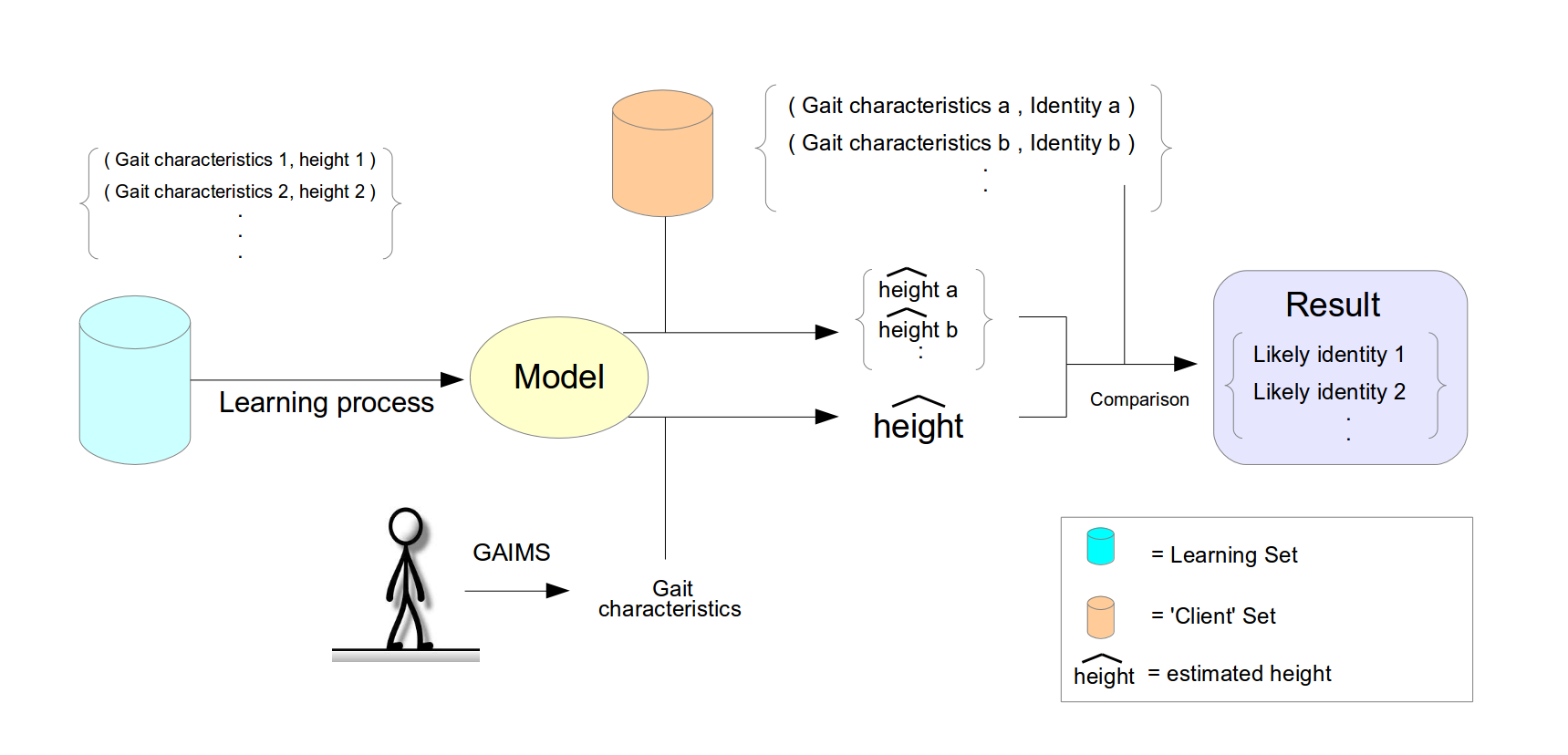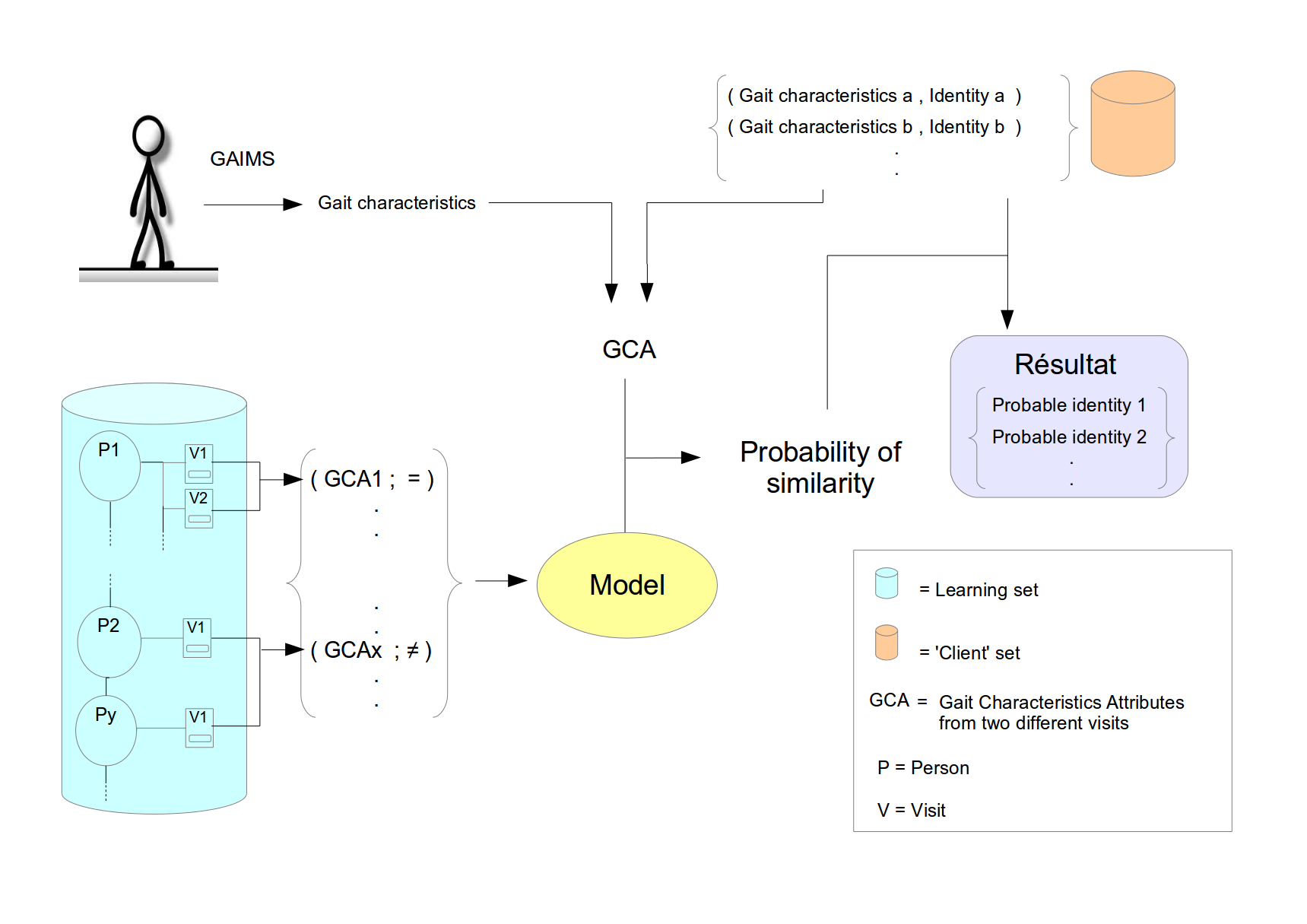- The project GAIMS
- Applications
- Publications
- Contact
- Acknowledgements
In her master’s thesis [1], Sophie Lejeune has done an exploratory work in order to determine the potential of our system GAIMS [2] [3] [4] [5] for people recognition [6]. Although the report’s conclusion shows that there is still a considerable amount of work to be done in this area, the high potential of GAIMS for identifying people has been clearly demonstrated. Even if there exist in the scientific literature many papers devoted to the identification of individuals based on their gait, those methods are most of the time based on color cameras, and to our knowledge, this is the first work that focuses on the use of only range laser sensors. This thesis highlighted the advantages of our technology based on the seven criteria commonly used to assess biometrics recognition systems.
The database used in this work, which has a size comparable to those used by other authors, gathers the gait characteristics of 114 people, acquired with GAIMS. Among these, 41 people were recorded at least five times to take the intra-subject variability into account. In this exploratory work, we have chosen to adopt the same protocol as the one we use for medical applications. As it is quite long for being used in practice, the report includes an assessment of the importance of the different walking tests that were asked to the volunteers, and highlights the possibility to build a gait recognition system based on much less recorded data.
Three gait recognition systems are proposed, implemented, and evaluated in the thesis. They are all based on machine learning techniques, and in particular, on the ExtRaTrees [7]. As a gait recognition system can be replicated in many different places (the “clients”), each with a different set of users, one must distinguish the case where the client must only establish its database and uses a generic gait recognition model, from the case where the client has to execute a machine learning algorithm to create a model optimized for him, in addition to the creation of his database.
The first system is based on 3 morphological characteristics estimated from the gait characteristics measured by GAIMS. Two regressors estimate the height and the weight of the person, and a classifier estimates the probability that the observed person is a woman. We have noted that the performance of our gender estimator based on range laser data is comparable to the performance of the best gender estimators based on video sequences known in the literature. The use of each morphological characteristics separately as well as a combination of them are considered. A gait recognition based only on the estimated morphological characteristics significantly reduces the proportion of falsifiable information taken into account in the identification. As the morphological characteristics estimators based on ExtRaTrees are biased in regression, it is proposed to compensate for these biases by placing, in the database of the client, the morphological characteristics estimated by the system during the first acquisition, instead of the real ones. As expected, it has been observed that the recognition system performs better by doing so.

| Figure 1. This figure depicts the first system of gait recognition which is proposed, implemented, and evaluated in Sophie Leujeune’s thesis. Image source: [1]. |
The second system uses a model that predicts the similarity between two vectors of gait characteristics measured by GAIMS. In comparison to the first system, this approach does not require to determine explicitly the intra-individual gait variability. Indeed, it is estimated automatically by the machine learning method that creates the similarity model, and included in it. The system returns a subset (of variable size) of the client database, which contains the most likely identities. We have obtained a risk of "loosing" the person in this pruning as low as 10% if, on average, 90% of the client database is rejected. It is therefore a promising technique if it is coupled to another modality. Furthermore, it has been show that the degradation of performance is reasonable if the gait is observed on a short path instead of our complete acquisition protocol.

| Figure 2. This figure depicts the second system of gait recognition which is proposed, implemented, and evaluated in Sophie Leujeune’s thesis. Image source: [1]. |
The third system is identical to the second one, except that the similarity model is particularized for the client. The results obtained with this last system suggest that it is possible to achieve a correct recognition rate of 100%, for clients needing to recognize a person among 41.
Bibliography
- S. Lejeune. Reconnaissance de personnes sur base des caractéristiques de la marche observées avec des capteurs laser. Master's thesis, University of Liège, Belgium, 2014.
- S. Piérard, S. Azrour, R. Phan-Ba, and M. Van Droogenbroeck. GAIMS: A reliable non-intrusive gait measuring system. ERCIM News, 95:26-27, October 2013. [ get the document via orbi ]
- S. Belachew, S. Piérard, R. Phan-Ba, and M. Van Droogenbroeck. Multimodal evaluation of gait and stride dynamics in relapsing and progressive forms of multiple sclerosis. Proceedings of the Belgian Royal Academies of Medecine, 1:66-69, 2012. [ get the document via orbi ]
- S. Piérard, R. Phan-Ba, V. Delvaux, P. Maquet, and M. Van Droogenbroeck. GAIMS: a powerful gait analysis system satisfying the constraints of clinical routine. Multiple Sclerosis Journal, 19(S1):359, October 2013. Proceedings of ECTRIMS/RIMS 2013 (Copenhagen, Denmark), P800. [ get the document via orbi ]
- S. Piérard, S. Azrour, and M. Van Droogenbroeck. Design of a reliable processing pipeline for the non-intrusive measurement of feet trajectories with lasers. In IEEE International Conference on Acoustics, Speech and Signal Processing (ICASSP), pages 4432-4436, Florence, Italy, May 2014. [ DOI | get the document via orbi | http ]
- N. Boulgouris, D. Hatzinakos, and K. Plataniotis. Gait recognition: a challenging signal processing technology for biometric identification. IEEE Signal Processing Magazine, 22(6):78-90, November 2005.
- P. Geurts, D. Ernst, and L. Wehenkel. Extremely randomized trees. Machine Learning, 63(1):3-42, April 2006. [ DOI ]